Embarking on the journey of stargazing offers a profound connection to the cosmos, revealing wonders from the rings of Saturn to distant galaxies. Finding the right amateur telescope is the first crucial step in unlocking these celestial treasures. Whether you’re captivated by the upcoming full moons, the distinct colors of stars in the Summer Triangle, Arcturus, and Antares, or the subtle glow of pre-dawn planets like Saturn, a capable telescope elevates your viewing experience from simply looking up to truly exploring the night sky. This guide cuts through the technical jargon to help you select the amateur telescope that perfectly matches your skill level, budget, and astronomical aspirations.
Buying your first amateur telescope can feel overwhelming given the multitude of options, specifications, and features available. Our expert reviews delve into the performance, ease of use, and overall value of various models, ensuring you can make an informed decision. From budget-friendly options ideal for beginners to advanced scopes for dedicated enthusiasts, we cover a range of choices designed to bring the universe closer. Discover how the right equipment can transform your view and deepen your appreciation for amateur astronomy. If you’re just getting started, finding the right amatuer telescope is key.
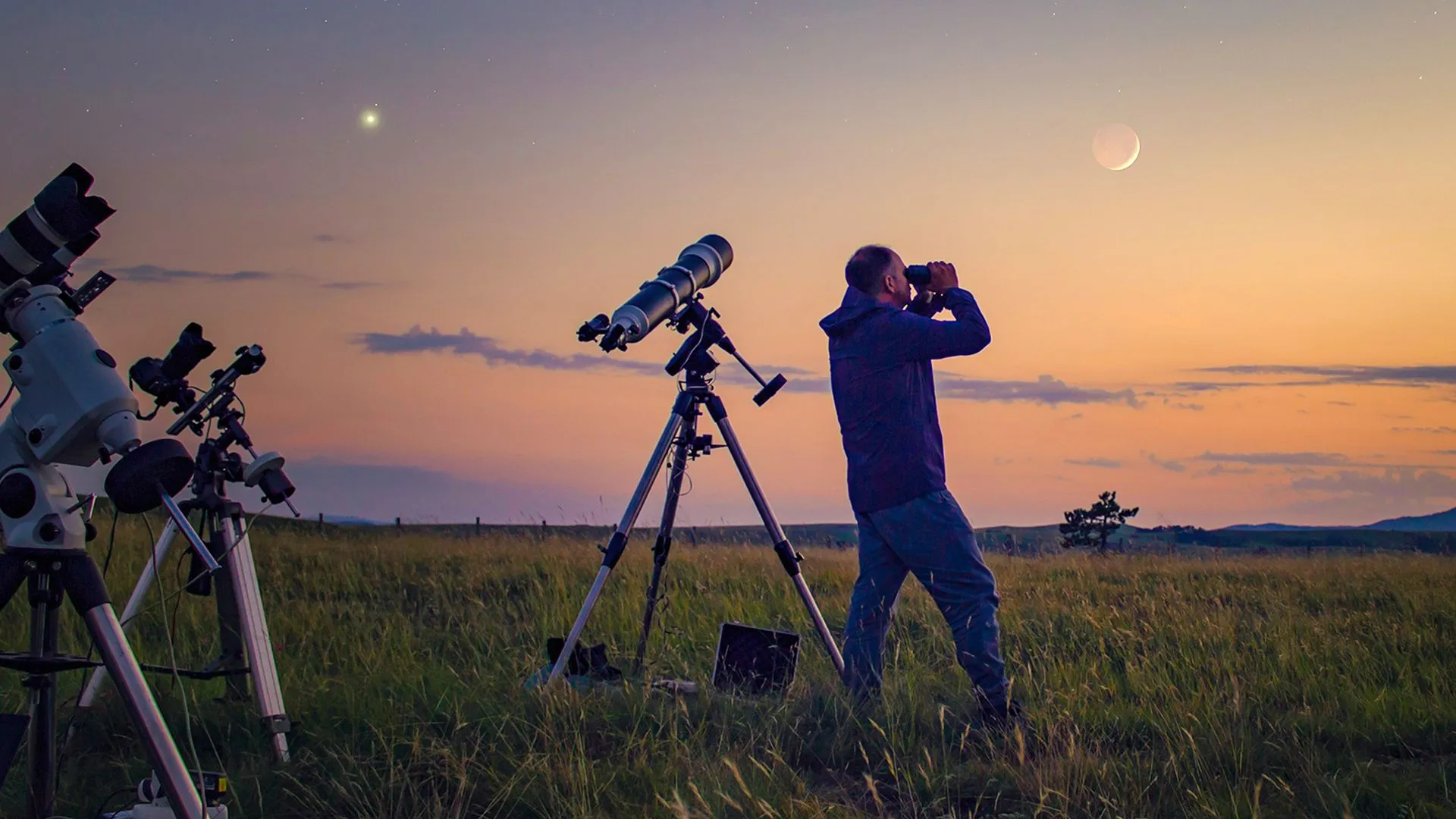 Man uses one of the best amateur telescope models to observe the sunset and night sky with telescopes set up on tripods around him
Man uses one of the best amateur telescope models to observe the sunset and night sky with telescopes set up on tripods around him
Top Recommended Amateur Telescopes for 2025
Navigating the world of astronomy gear requires insight into what makes a telescope truly effective for different purposes. Here are some of the leading amateur telescope models we recommend, spanning various needs and budgets.
| Model | Best For | Optical Design | Mount Type | Aperture |
|---|---|---|---|---|
| Celestron NexStar 4SE | Beginners / Finding Planets | Maksutov-Cassegrain | Computerized Alt-Azimuth | 102mm |
| Celestron Inspire 100AZ Refractor | Budget | Refractor | Alt-azimuth | 100mm |
| Celestron Astro Fi 130 | Value for Enthusiasts | Newtonian Reflector | Computerized Alt-azimuth | 130mm |
| Celestron NexStar Evolution 9.25 | Premium | Schmidt-Cassegrain | Computerized Alt-azimuth | 235mm |
| Celestron Origin Intelligent Home Observatory | Astrophotography | RASA | Motorized Alt-azimuth | 152mm |
| Celestron NexStar 8SE | Motorized / All-Rounder | Schmidt-Cassegrain | Computerized Alt-azimuth | 203mm |
| Celestron Astro Fi 102 | Portability | Maksutov-Cassegrain | Computerized Alt-Azimuth | 102mm |
| Sky-Watcher Skymax 150 PRO | Accessories / Astrophotography | Maksutov-Cassegrain | Equatorial (EQ-5 Pro) | 150mm |
| Unistellar eQuinox 2 telescope | Smart Telescope | Newtonian Reflector | Motorized GoTo alt-azimuth | 114mm |
| Celestron Advanced VX 8 EdgeHD | Deep Space / Advanced Astro | Schmidt-Cassegrain | Motorized equatorial | 203.2mm |
| Celestron FirstScope 76 Tabletop telescope | Kids / Casual | Reflector | Dobsonian | 76mm |
For those interested in exploring the vast array of options, comparing the top 10 amatuer telescopes can provide a clearer picture of what’s available on the market.
In-Depth Reviews: Finding Your Ideal Amateur Telescope
Choosing an amateur telescope involves more than just looking at price tags. It’s about matching the instrument’s capabilities with your viewing goals and comfort level. Here, we provide detailed insights into some of the most popular amateur telescope models available today.
Best Beginner Amateur Telescope: Celestron NexStar 4SE
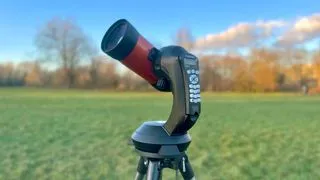 The celestron nexstar 4se set up outside in a field
The celestron nexstar 4se set up outside in a field
The Celestron NexStar 4SE is a fantastic entry point into the world of computerized stargazing, making it an excellent amateur telescope for beginners. Its primary appeal lies in the user-friendly GoTo technology, specifically Celestron’s SkyAlign. This system simplifies finding celestial objects; simply align on three bright stars, and the telescope does the rest, automatically slewing to and tracking targets. This removes the initial hurdle of manually locating objects, allowing newcomers to focus on the viewing experience.
This Maksutov-Cassegrain scope features a 4-inch (102mm) aperture and a long 1325mm focal length, providing crisp, bright views particularly well-suited for planets and the Moon. While the narrow field of view (1.2 degrees) makes finding large deep-sky objects challenging, the detail on brighter targets is impressive. It comes with a 25mm eyepiece, but adding a 32mm eyepiece and a Barlow lens can enhance its versatility. The build quality is sturdy, contributing to its 23 lbs (10.44kg) weight, which, while stable, impacts portability as the tripod doesn’t fold completely. Be aware it’s power-hungry, making an external power source highly recommended for backyard use. Overall, it’s a solid amateur astronomy telescope choice for hassle-free planetary observation from a fixed location like your backyard.
| Attributes | Notes |
|---|---|
| Design | Solid and sturdy build, signature orange colors. |
| Performance | Great for observing the moon and planets, clear and bright images. |
| Functionality | Auto-finds night sky objects, easy setup, requires external power. |
| Best Use Case | Beginners, viewing planets and bright objects from a backyard. |
| Portability | Not very portable due to weight and tripod design. |
| Primary Drawbacks | Narrow field of view, power consumption, limited supplied accessories. |
Best Budget Amateur Telescope: Celestron Inspire 100AZ Refractor
The Celestron Inspire 100AZ provides a valuable entry point as a budget-friendly amateur telescope option.
For those on a tighter budget or just dipping their toes into stargazing, the Celestron Inspire 100AZ Refractor stands out as an excellent value amateur telescope. It’s designed with beginners in mind, featuring a straightforward setup and user-friendly design. As an achromatic refractor with a 4-inch (100mm) aperture and 660mm focal length, it performs admirably for its price point, particularly excelling at views of the Moon and planets. The 100mm aperture gathers a decent amount of light for exploring brighter deep-sky objects too.
Mounted on a simple altazimuth mount, it moves intuitively up/down and side/side. While lacking GoTo technology, making manual object location necessary (perhaps with a stargazing app), this encourages learning the sky. Reviewers noted some minor chromatic aberration (purple fringing) and slight blurring at the field edges, which can be improved by upgrading the included 10mm and 25mm Kellner eyepieces. A unique feature is the lens cap that converts into a smartphone adapter, allowing for easy astrophotography attempts. It’s a lightweight (20 lbs / 9.07kg) and portable option, making it a good backyard telescope or one to take to slightly darker locations.
| Attributes | Notes |
|---|---|
| Design | Fairly lightweight, includes helpful accessories. |
| Performance | Sharp views of planets and the moon, some chromatic aberration noted. |
| Functionality | Easy to set up, handy smartphone adaptor, built-in red light. |
| Best Use Case | Beginners, budget-conscious users, lunar and planetary viewing. |
| Portability | Lightweight and easy to handle. |
| Primary Drawbacks | Manual object locating, requires eyepiece upgrades for best views. |
Best Value Amateur Telescope for Enthusiasts: Celestron Astro Fi 130
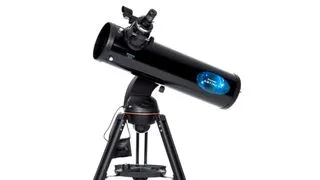 The Celestron Astro Fi 130 on a white background
The Celestron Astro Fi 130 on a white background
Stepping up in capability while maintaining excellent value, the Celestron Astro Fi 130 is a compelling amateur telescope for enthusiasts ready for more. This Newtonian Reflector boasts a 5.19-inch (130mm) aperture and a relatively short 650mm focal length, providing a wider field of view compared to Casssegrain designs, which is beneficial for observing larger deep-sky objects like galaxies and nebulas. It combines solid optics with computerized GoTo functionality controlled entirely via your smartphone or tablet using the Celestron SkyPortal app. This app not only controls the telescope but also acts as a guide, recommending objects currently visible.
Users found the setup easy thanks to SkyAlign, and the app interface is intuitive. While the included 10mm and 25mm Kellner eyepieces are functional, upgrading them is recommended to unlock the telescope’s full potential. Its portability (18 lbs / 8.6kg) and automated features make it a great grab-and-go option for quick observing sessions. However, it relies heavily on the app and power (batteries can drain quickly, especially in cold), so an external power source is advisable. Despite some minor flaws, its blend of aperture size, GoTo technology, and attractive price point makes it a strong contender for an enthusiast’s hobby telescope.
| Attributes | Notes |
|---|---|
| Design | Sturdy build, portable. |
| Performance | Good views of moon/planets, capable of showing brighter deep sky. |
| Functionality | App-controlled GoTo, easy setup, recommends targets. |
| Best Use Case | Enthusiasts, beginners wanting GoTo, mobile-controlled astronomy. |
| Portability | Good. |
| Primary Drawbacks | Reliant on app, battery drain, included eyepieces could be better. |
Best Premium Amateur Telescope: Celestron NexStar Evolution 9.25
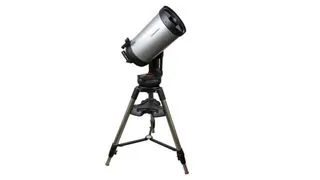 The Celestron NexStar Evolution 9.25 on a tripod on a white background
The Celestron NexStar Evolution 9.25 on a tripod on a white background
The Celestron NexStar Evolution 9.25 is designed for the serious amateur telescope enthusiast or those seeking top-tier performance and features. This Schmidt-Cassegrain boasts a massive 9.25-inch (235mm) aperture and a very long 2350mm focal length. The large aperture gathers a tremendous amount of light, revealing stunning detail on a wide range of celestial objects, from planets and the Moon to deep-sky galaxies and nebulas. The views are consistently crisp and defect-free.
It sits on a robust computerized alt-azimuth fork arm mount, featuring a built-in rechargeable lithium-ion battery providing up to 10 hours of power – a significant advantage over battery-hungry models. Setup is straightforward, surprisingly so for its size. Control is available via the included hand controller or the free Celestron SkyPortal app. Its precision tracking also makes it suitable for astrophotography. However, this premium performance comes at a price. It’s a significant investment and its weight (62.60 lbs / 28.39kg) means it’s best suited as a good backyard telescope rather than a portable option.
| Attributes | Notes |
|---|---|
| Design | High-quality, robust build. |
| Performance | Crisp, detailed views of wide range of objects, no defects. |
| Functionality | Easy setup, excellent GoTo tracking, long-lasting rechargeable battery. |
| Best Use Case | Experienced enthusiasts, backyard stargazers, potential for astrophotography. |
| Portability | Not very portable. |
| Primary Drawbacks | High price point, heavy. |
Best Amateur Telescope for Astrophotography: Celestron Origin Intelligent Home Observatory
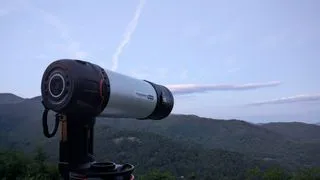 a black and white telescope in a field
a black and white telescope in a field
For the amateur telescope user whose primary goal is astrophotography, especially of deep-sky objects, the Celestron Origin Intelligent Home Observatory is a revolutionary, albeit pricey, option. Unlike traditional telescopes, the Origin is a “smart” telescope that lacks an eyepiece. Instead, it features a built-in camera (6.2MP sensor) and displays views directly on a connected mobile device via its intuitive app. Using Rowe-Ackermann Schmidt Astrograph (RASA) optics with a 6-inch (152mm) aperture and 335mm focal length, it excels at capturing wide-field images.
The system automatically handles focusing, tracking, and image stacking, producing crystal-clear deep-sky photos in seconds, even from light-polluted areas. The accompanying app is user-friendly, offering a “Planetarium View” to easily select targets. While it excels at nebulas and galaxies, reviewers found imaging planets less successful. Setup is quick thanks to Autonomous Field Detection. Its price tag (around $4,000) and weight (41.6 lbs / 18.6 kg) mean it’s a significant investment best suited for dedicated astrophotographers who prioritize automation and rapid deep-sky imaging from a relatively fixed location. It’s less versatile as an all-around viewing instrument. This represents a shift in what an amateur astronomy telescope can be.
| Attributes | Notes |
|---|---|
| Design | Looks like a classic scope but without an eyepiece, handles for carrying. |
| Performance | Produces beautiful, clear deep-sky photos quickly. |
| Functionality | Fully automated (focus, track, stack), app-controlled, Smart Light Reduction. |
| Best Use Case | Dedicated astrophotographers, users in urban areas, tech-savvy users. |
| Portability | Quite large and heavy. |
| Primary Drawbacks | No eyepiece for visual observing, expensive, less ideal for planets. |
Best Motorized Amateur Telescope: Celestron NexStar 8SE
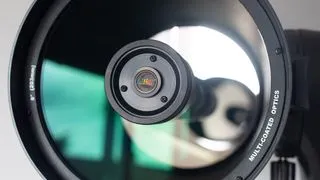 Celestron NexStar 8SE review photo
Celestron NexStar 8SE review photo
Often hailed as “The World’s Most Beloved Telescope,” the Celestron NexStar 8SE is a highly versatile amateur telescope suitable for users across all experience levels. Its 8-inch (203mm) Schmidt-Cassegrain optics gather substantial light, providing incredibly bright and sharp views of everything from planets and the Moon to numerous deep-sky objects. The clarity is impressive across the entire field of view.
The computerized alt-azimuth fork arm mount makes it incredibly user-friendly. Using Celestron’s SkyAlign (aligning on three bright stars), the mount can then automatically slew to over 40,000 objects in its database via the included hand controller. The automated tracking makes it a great option for beginners and also capable for long-exposure astrophotography (though requiring specific accessories and techniques). Its catadioptric design keeps the tube relatively compact (2032mm focal length), making it reasonably portable for an 8-inch scope (32 lbs / 14.48kg total). While it is an investment, its performance and longevity offer excellent value. Like the 4SE, it’s power-hungry, needing 8x AA batteries, so rechargeable ones or an external power source are recommended for a good backyard telescope.
| Attributes | Notes |
|---|---|
| Design | Robust, compact orange tube, easy to handle. |
| Performance | Incredibly bright, sharp views across the field, excellent optics. |
| Functionality | Easy motorized GoTo via hand controller, great tracking for astro. |
| Best Use Case | Beginners to advanced, viewing solar system and deep sky, astrophotography capable. |
| Portability | Reasonably portable for its aperture size. |
| Primary Drawbacks | Pricey for beginners, battery consumption, hand controller can be slightly laggy. |
Best Portable Amateur Telescope: Celestron Astro Fi 102
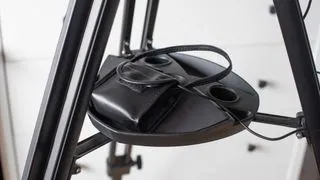 The Celestron Astro Fi 102
The Celestron Astro Fi 102
For stargazers living in light-polluted areas or those who love camping and travel, portability is paramount. The Celestron Astro Fi 102 is designed with this in mind, making it an excellent portable amateur telescope. Weighing in at a mere 6 lbs (2.7kg) with a compact body (102mm Maksutov-Cassegrain optics, 1325mm focal length), it’s exceptionally easy to carry. Setup is relatively straightforward, and it features integrated WiFi for control via the Celestron SkyPortal app on your smartphone or tablet, offering access to a database of 100,000 celestial objects for easy GoTo navigation. This makes it highly beginner-friendly.
The 102mm aperture provides good views of the Moon and closer planets like Mars, Saturn, and Jupiter for its size and price. While there’s some sharpness drop-off at the edges, this is common in this price range. The tripod, while lightweight for portability, feels a bit flimsy and might need extra weighting for stability. The plastic casing is functional but not as robust or sealed as more expensive models, requiring care in damp conditions. Despite some compromises in build quality and optics compared to pricier options, its unbeatable portability and automated features make it a great choice for on-the-go amateur astronomy telescope sessions, especially for beginners focusing on brighter objects.
| Attributes | Notes |
|---|---|
| Design | Very lightweight and compact. |
| Performance | Good views of Moon and planets, some edge sharpness drop-off. |
| Functionality | WiFi control via app, easy GoTo, large object database. |
| Best Use Case | Portable observing, beginners, users in light-polluted areas. |
| Portability | Excellent, very lightweight. |
| Primary Drawbacks | Tripod feels flimsy, optics could be sharper, not very robust build. |
Best Amateur Telescope for Accessories: Sky-Watcher Skymax 150 PRO
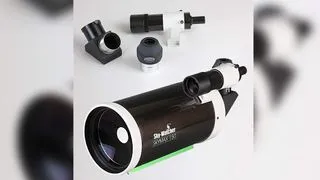 The Sky-Watcher Skymax 150 and accessories laid on a white table
The Sky-Watcher Skymax 150 and accessories laid on a white table
For the amateur telescope user who wants a versatile instrument capable of accommodating a wide range of accessories, especially for astrophotography, the Sky-Watcher Skymax 150 PRO is a strong contender. This Maksutov-Cassegrain scope features a 5.90-inch (150mm) aperture and a long 1800mm focal length, offering excellent optical quality with crisp, distortion-free views suitable for both visual observing and imaging. Its compact design and relatively light weight (13.23 lbs / 6kg for the tube) make it reasonably portable, ideal for trips to darker skies.
What sets it apart is its flexibility for astrophotography setups. It features a Vixen-style dovetail plate for easy attachment to various equatorial mounts (often sold separately or as a package), and the optical design is well-suited for adding accessories like CCD or DSLR cameras, filter wheels, and more. The focuser is smooth and holds focus well, crucial for imaging. While it typically comes with only one eyepiece (28mm), its optical performance and accessory compatibility make it a valuable hobby telescope for those serious about astrophotography across a range of targets, from planets to nebulas and galaxies.
| Attributes | Notes |
|---|---|
| Design | High quality build, compact tube design. |
| Performance | Excellent optics, crisp and distortion-free views. |
| Functionality | Accommodates wide range of accessories, smooth focuser. |
| Best Use Case | Astrophotographers, users wanting flexibility for setups, portable imaging. |
| Portability | Reasonably portable tube. |
| Primary Drawbacks | Often sold without a tripod/mount, comes with only one eyepiece. |
Best Smart Amateur Telescope: Unistellar eQuinox 2 telescope
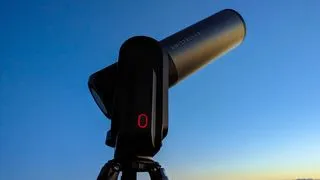 Telescope in-use against night sky
Telescope in-use against night sky
The Unistellar eQuinox 2 is a cutting-edge amateur telescope that redefines the viewing experience through smart technology. Like the Celestron Origin, it lacks a traditional eyepiece, relying entirely on an integrated camera (6.2MP) to display enhanced images on a connected mobile device via the Unistellar app. This 4.49-inch (114mm) Newtonian Reflector with a 450mm focal length is incredibly simple to use: power it on, connect the app, and within minutes it can autonomously locate and image celestial objects thanks to its GoTo alt-azimuth mount and Autonomous Field Detection.
Its key selling point is the “Smart Light Pollution Reduction” feature, which effectively filters out urban light pollution, allowing users to see deep-sky objects clearly even from city locations. The app makes navigation easy, showing available targets and allowing quick selection and slewing. The telescope captures multiple short exposures and stacks them in real-time, making objects appear brighter and more detailed on screen. While the image resolution (6.2MP) is only average, the ease of use and light pollution mitigation are significant benefits, especially for newcomers in urban environments. It’s a premium-priced device (around $2,000) offering a streamlined, modern amateur astronomy telescope experience, though it’s not for those who prefer direct visual observing.
| Attributes | Notes |
|---|---|
| Design | Sleek, modern, no eyepiece, single power button. |
| Performance | Excellent light pollution reduction, quickly images deep sky objects. |
| Functionality | Fully app-controlled, autonomous setup and tracking, real-time stacking. |
| Best Use Case | Urban stargazers, tech-savvy users, those prioritizing ease of use and automated imaging. |
| Portability | Portable but lacks handles, around 19.8 lbs (9kg). |
| Primary Drawbacks | Expensive, no visual observing via eyepiece, average image resolution. |
Best Amateur Telescope for Deep Space: Celestron Advanced VX 8 EdgeHD
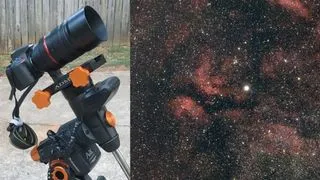 Review photo of the Celestron Advanced VX8 Edge HD
Review photo of the Celestron Advanced VX8 Edge HD
The Celestron Advanced VX 8 EdgeHD is built for the serious amateur telescope user and astrophotographer focused on achieving pinpoint sharpness across the entire field of view, especially for deep-space targets. It features 8-inch (203.2mm) EdgeHD optics, a proprietary Schmidt-Cassegrain design that corrects for field curvature, ensuring stars at the edges of images or views are as sharp as those in the center. This is a major advantage for astrophotography using CCD or DSLR cameras.
It comes bundled with the robust and reliable Advanced VX motorized equatorial mount. This mount is designed for imaging, capable of tracking objects smoothly across the meridian and supporting a substantial payload (up to 30 lbs / 13.6kg) including cameras and accessories. While setting up an equatorial mount requires some understanding of the celestial poles, the computerized GoTo system (controlled via hand controller or PC/app) makes finding and tracking objects straightforward once aligned. The optical performance is superb, providing detailed views of everything from planets to faint 12th magnitude galaxies under dark skies. It’s a significant investment (61 lbs / 27.67kg total weight makes it less portable), aimed at experienced astronomers who want a high-performance amateur astronomy telescope that they won’t quickly outgrow.
| Attributes | Notes |
|---|---|
| Design | High-quality optics and robust mount. |
| Performance | Excellent sharpness across the field, great light gathering for deep space. |
| Functionality | Reliable motorized equatorial mount, GoTo system, optimized for astrophotography. |
| Best Use Case | Serious amateurs, astrophotographers, deep-space observing. |
| Portability | Heavy, less portable. |
| Primary Drawbacks | Requires some astronomy knowledge for setup, comes with only one eyepiece, expensive. |
Best Amateur Telescope for Kids: Celestron FirstScope 76 Tabletop telescope
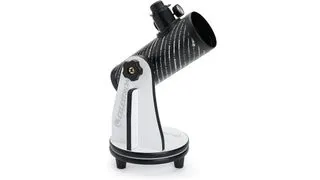 Celestron FirstScope on a white background
Celestron FirstScope on a white background
Introducing children to the wonders of the night sky requires an amateur telescope that is simple, robust, and provides satisfying initial views without being overly complex or expensive. The Celestron FirstScope 76 Tabletop telescope fits this role perfectly. This Newtonian Reflector has a 2.99-inch (76mm) aperture and a short 300mm focal length (f/3.95), making it very portable (4.5 lbs / 2.04kg) and easy to handle, even for small hands. It arrives fully assembled, meaning it’s ready for use right out of the box – ideal for impatient young astronomers.
It sits on a simple Dobsonian tabletop mount, which is intuitive to point by hand. While requiring a sturdy table for comfortable viewing, this mount type is incredibly user-friendly. The 76mm aperture is capable of showing impressive views of the Moon’s craters and brighter deep-sky objects like nebulas and galaxies, providing that initial “wow factor” for young observers. It includes two basic eyepieces (4mm and 20mm). The build is surprisingly sturdy for its low price. The main drawback is the lack of a finderscope, which makes locating specific objects more challenging. Purchasing an inexpensive red dot finder is highly recommended to improve usability. Despite this, it’s a fantastic low-investment amateur telescope for casual family stargazing and sparking curiosity in young minds.
| Attributes | Notes |
|---|---|
| Design | Robust, compact tabletop design. |
| Performance | Good views of Moon, provides initial “wow factor”. |
| Functionality | Arrives assembled, very easy to use Dobsonian mount. |
| Best Use Case | Kids, beginners, casual viewing, low budget. |
| Portability | Very portable tube, requires a table for use. |
| Primary Drawbacks | No finderscope included, views lack fine detail, loose focuser. |
Choosing the Right Amateur Telescope: A Beginner’s Guide
Selecting your first amateur telescope can be a significant decision. Beyond the specific models reviewed, understanding the fundamentals of how telescopes work and the different types available is crucial. This section provides essential guidance to help you make the best choice for your amateur astronomy journey. Finding the right amatuer telescope is key.
How Do I Choose the Right Amateur Telescope?
Choosing the right amateur telescope involves balancing several factors:
- Your Budget: Telescopes range from under $100 to several thousand. Define how much you’re willing to spend.
- Your Viewing Goals: What do you want to look at? Planets and the Moon require high magnification and good contrast. Deep-sky objects (galaxies, nebulas) require larger aperture to gather more light. Astrophotography requires stable tracking mounts and specific optical designs.
- Your Location: Are you observing from a light-polluted city backyard or able to travel to dark sky sites? Portability matters for the latter. Urban viewing often benefits from specific telescope types or filters.
- Your Experience Level: Beginners often prefer user-friendly designs like Alt-Azimuth mounts or computerized GoTo systems. Experienced users might opt for more powerful, potentially complex Equatorial mounts for imaging.
- Portability: How easy is the telescope to set up, take down, and transport? Size and weight are key considerations.
Consider these points carefully before committing to a specific hobby telescope. Stick to reputable dealers who offer warranties and support.
What Types of Amateur Telescope Are There?
There are three primary types of amateur telescope, each with different ways of collecting and focusing light:
- Refractors: Use lenses to bend light. Simple design, low maintenance, good for planetary/lunar views due to high contrast. Can suffer from chromatic aberration (color fringing) in cheaper models. Require longer tubes for higher magnification.
- Reflectors: Use mirrors to reflect light. Offer the most aperture for your money, making them great for deep-sky objects. Require periodic mirror alignment (collimation) and some maintenance. Newtonian design is common.
- Catadioptrics (Compound): Use both lenses and mirrors. Compact design for their aperture, versatile for both visual and astrophotography. Often more expensive than refractors or reflectors of similar aperture. Schmidt-Cassegrain and Maksutov-Cassegrain are common types.
Dobsonian telescopes are a type of mount (simple alt-azimuth) often used with Newtonian reflectors to provide a stable, cost-effective platform for large apertures, making them excellent value for visual deep-sky observing. For many, a Newtonian reflector on a Dobsonian mount offers the best balance of aperture and price in an amateur astronomy telescope.
Understanding Your Amateur Telescope: Aperture, Magnification, and Focal Length
Navigating telescope specifications requires understanding a few key terms:
- Aperture: The diameter of the main lens (refractor) or primary mirror (reflector/catadioptric). This is the most important specification. A larger aperture collects more light, revealing fainter objects and finer details.
- Focal Length: The distance from the main lens/mirror to the point where light converges to form an image. A longer focal length provides higher potential magnification and is often found in telescopes good for planets. A shorter focal length provides a wider field of view, better for large deep-sky objects. It’s measured in millimeters (mm).
- Magnification: How much larger an object appears. It’s calculated by dividing the telescope’s focal length by the focal length of the eyepiece being used. You can change eyepieces to change magnification. However, there’s a limit to useful magnification (roughly 50x per inch or 2x per mm of aperture) before the image becomes dim and blurry due to atmospheric conditions and the telescope’s optics.
For example, a telescope with a 1000mm focal length used with a 10mm eyepiece provides 100x magnification (1000 / 10 = 100).
Magnification: How Do Telescope Eyepieces Work?
Eyepieces are small lenses inserted into the telescope’s focuser. They take the light gathered by the main optics and magnify the image. Each eyepiece has its own focal length (measured in mm). As explained above, a shorter eyepiece focal length results in higher magnification with any given telescope. A longer eyepiece focal length provides lower magnification and a wider field of view.
A versatile amateur telescope setup typically includes several eyepieces to provide a range of magnifications – perhaps a low-power (long focal length) eyepiece for wide-field views and finding objects, a medium-power one for general observing, and a high-power (short focal length) one for detailed views of planets and the Moon when atmospheric conditions are steady. Quality of eyepieces also significantly impacts the view.
What is a Finderscope?
A finderscope is a small aiming device attached to the main telescope tube. Because the main telescope often has a narrow field of view (showing only a tiny patch of sky), it can be difficult to locate objects. The finderscope, with its low magnification and wide field of view, shows a much larger area of the sky, making it easier to star-hop or point the main telescope accurately towards your target.
Once you center the desired object in the finderscope’s field (often marked with crosshairs or a red dot), it should then be visible in the main telescope’s eyepiece. Different types of finderscopes exist, including straight-through models, right-angle models (easier for looking up), and red dot finders (projecting a dot onto a clear window). Some advanced computerized telescopes use sophisticated alignment procedures or built-in cameras instead of a separate finderscope.
Conclusion: Embracing the Sky with Your Amateur Telescope
Choosing the right amateur telescope is an exciting part of beginning or advancing your journey in exploring the universe. It’s about finding an instrument that not only fits your practical needs but also inspires you to spend more time under the stars. From simple, portable refractors ideal for young skywatchers to powerful, automated systems for dedicated astrophotographers, there’s an amateur telescope out there for everyone. Consider your goals, your budget, and the kind of celestial wonders you most want to unveil. Armed with the right knowledge and equipment, the night sky becomes your personal playground, filled with endless discovery. Don’t hesitate to take the leap and find the amatuer telescope that will accompany you on countless nights of cosmic exploration.
